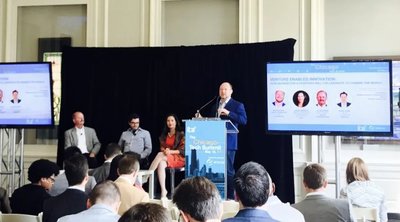At Wednesday’s first annual ITA Chicago Tech Summit, Terry moderated a panel regarding how venture-enabled innovation will change the world with U of I Director, Research Park & Economic Development Laura Frerichs, VP at Shure Corporation Al Hershner, and Lead Integration Engineer at SwiftIQ David Purdy. The makeup of the panel is important to note because it allowed for a dynamic conversation from the viewpoint of a higher education research arm, an enterprise, an entrepreneur, and a venture collaborator, all of which have experienced the endless opportunity – and pain – that can be created when large and small organizations work together. The common theme that kept bubbling to the top was that enterprises and entrepreneurs speak different languages, face different challenges and want the same thing: growth.
A few key takeaways for entrepreneurs stemming from the panel:
“Don’t Be a Hammer Looking for a Nail”
All members of the panel, particularly SwiftIQ, noted this common startup issue. Entrepreneurs create a product or service that they are personally, passionately devoted to. They know its purpose, the challenge it will solve, the difference it will make to the world. They may not, however, take a step back to consider if their product is the right hammer for the enterprise’s nail.
For instance, large organizations have established processes, approval layers, defined R&D and purchasing plans and more. When a startup comes in with an idea that completely disrupts status quo and throws all of that away, it is incredibly intimidating to any enterprise organization. The resounding advice from the panel was alternatively to suggest a six-month pilot that both the enterprise and the entrepreneur can be comfortable with. It shows that both players are flexible and proves that the startup can solve several different types of problems. In a hub and spoke manner, their solution can be expanded from one region to nation-wide or one industry to new similar verticals and so on. With each win on the board, more trust is earned from both organizations.
Get to a “No”
For entrepreneurs, the value of having meetings with enterprises early on is that there are only two potential outcomes from the conversation, both of which are critical to the growth of the startup. Yes, which means there will be a pilot, investment, or contract. Or no, which means the entrepreneur needs to refine his or her pitch. The latter is surprisingly difficult for an enterprise to declare.
For SwiftIQ, having a meeting with a large eCommerce company early, allowed them to hear “no” quickly. SwiftIQ originally went into the meeting offering a wide breadth of consumer data that covered a lot of ground. It was too complicated. From that “no,” they were able to identify what the company was looking for and would be willing to pay for. SwiftIQ realized that the data engine behind their original pitch – the ability to understand what people were doing and why – provided the functionality that the eCommerce company needed. That concept was the diamond in the rough. Instead of selling the full suite of 10 offerings from the original pitch, they were able to identify the one key offering that then became the core focus of the business.
Be Open to the “Unintended Value Proposition”
While entrepreneurs receive “no” more often than not, they also learn valuable lessons with each rejection. Primarily, they learn to listen.
An AgTech startup out of the University of Illinois’ Research Park - Agrible - knew their target audience was individual farmers. They founded the company to provide growers with tools to increase productivity, efficiency and sustainability.
By listening during each customer interaction, they discovered unexpected partnership opportunities. For instance, they found a mutually beneficial relationship with Archer Daniels Midland Company (NYSE: ADM). ADM was able to provide already-established Midwest customers, aerial imagery, and crop boundary documentation, while Agrible was able to provide better yield predictions and increased value to ADM customers. ADM ultimately became Agrible’s first strategic investor.
In rounding out the discussion, the panelists were able to shed light on ways to collaborate and earn value from their counterparts. The secret is in remaining flexible, getting a firm answer and listening for the hidden gem in the conversation.
